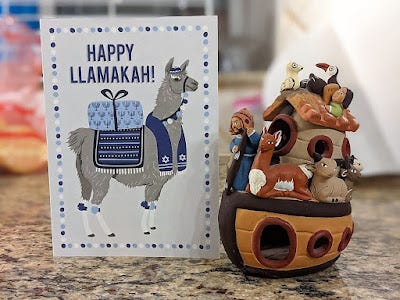Unpacking an Ark

The first of the Noah's Arks for the new exhibit at the Biblical Museum of Natural History just arrived in Israel, and it's a beauty! It's also very, very unusual. Many model Arks tell an interesting story, if you only know how to unpack it. This one is no exception, and a careful study of its details reveals where it was made and why it is different from other model Arks.
The first thing to take note of with any model Ark is the material that it is made from. Arks are made from all kinds of materials, including different types of wood, ceramic, porcelain, resin, and metal. But this one is hand-made of red clay. This indicates that it was made in a country where traditional art is produced in such a way.
Then there's the architecture of the Ark to consider. It's perhaps difficult to tell from the picture, but it's much more rounded than models usually are. And the roof is designed to look like curved terracotta tiles, rather than a flat material. These aspects are indicative of Spanish architecture.

Then there's an extremely curious detail. Perched on the middle of the roof, between the two birds, are two gourds, with lines on them. What are they doing there?
But the real giveaway, and the most fascinating aspect of this Ark, are the animals that appear on it - and the ones that don't appear on it.
In general, there are certain animals that always appear on Arks. Giraffes are far and away the most prominent, iconic and common. There's usually also elephants, lions, and often zebras. Yet none of those animals appear on this Ark!

Instead, we have some very unusual species here. Flanking Noah on both sides are llamas! And the bird perched on the roof, accompanying the dove, is a toucan!
All this is a clear giveaway as to this Noah's Ark's origins. It must have been made in South America, specifically Peru. There are no giraffes or lions in South America or its culture, but there are plenty of llamas and toucans. The architecture is Spanish. Peru in particular is rich in clay, which is long-favored for use in traditional art. And another traditional art form in Peru, practiced for thousands of years, is the intricate carving of large gourds.
Flood stories have long been widespread around the world. But this is the Biblical story transplanted to a South American setting! It's a really special piece of art with which to begin the museum's collection.
Meanwhile, we have several other very special Noah's Arks sitting in various peoples' homes around the world, and due to the new Covid restrictions, all of the people who were supposed to bring them to Israel are now unable to do so! So if you happen to know of anyone traveling in from New York, New Jersey, Los Angeles, Toronto, or Melbourne who is able to bring an Ark, please let me know!



